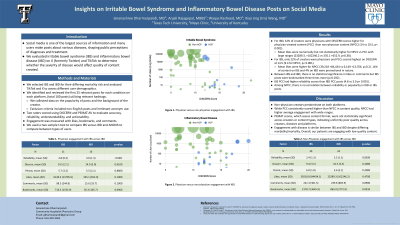Tuesday Poster Session
Category: Practice Management
P4918 - Insights on Irritable Bowel Syndrome and Inflammatory Bowel Disease Posts on Social Media
Tuesday, October 29, 2024
10:30 AM - 4:00 PM ET
Location: Exhibit Hall E

Has Audio

Gnanashree Dharmarpandi, MD
Texas Tech University Health Sciences Center
Amarillo, TX
Presenting Author(s)
Gnanashree Dharmarpandi, MD1, Anjali Rajagopal, MBBS2, Waqas Rasheed, MD3, Xiao Jing (Iris) Wang, MD2
1Texas Tech University Health Sciences Center, Amarillo, TX; 2Mayo Clinic, Rochester, MN; 3University of Kentucky, Lexington, KY
Introduction: Social media is one of the largest sources of information and many users make posts about various diseases, shaping public perceptions of diagnoses and treatment. We evaluated irritable bowel syndrome (IBS) and inflammatory bowel disease (IBD) on X (formerly Twitter) and TikTok to determine whether the severity of disease would affect quality of content created.
Methods: We selected IBS and IBD for their differing mortality risk and analyzed TikTok and X to assess different user demographics. We identified and reviewed the first 25 relevant posts for each condition on each platform, (total 100 posts) utilizing relevant hashtags. Exclusion criteria included non-English posts and irrelevant acronym use. We collected data on the popularity of posts and the background of the creator. Two raters scored using DISCERN and PEMAT-AV to evaluate accuracy, reliability, understandability, and actionability. Engagement was measured with likes, bookmarks, and comments. We used a two sample t-test to compare IBS versus IBD and ANOVA to compare between types of users.
Results: For IBD, 32% of creators were physicians with DISCERN scores higher for physician-created content (PCC) than non-physician content (NPCC) (14 vs 10.5, p< 0.001). Mean likes were numerically but not statistically higher for NPCC vs PCC with large ranges (23289.3, +102246.2 vs 335.1 +652.9, p=0.38). For IBS, only 22% of creators were physicians and PCCs scored highest on DISCERN at 14.5 (9.4 for NPCC, p< 0.001). Mean likes were higher for NPCC (39,218 +84,434 vs 6,149 +13,706, p=0.2). 14% of content on IBS and 4% on IBD were promotional in nature. Between IBS and IBD, there is no statistical significance in likes or comments but IBS posts were bookmarked three times more (p=0.032) . IBS PCC had higher reliability scores than IBD PCC posts (4.8 vs 3.0 p< 0.001). Among NPCC, there is no correlation between reliability or popularity in IBD or IBS posts.
Discussion: Non-physician creators predominate on both platforms. While PCC consistently scored higher than NPCC in content quality, NPCC had higher average engagement with wide ranges. PEMAT scores, which assess content format, were not statistically significant across creators or content types, indicating uniformly poor quality across creators, diseases and platforms. Engagement with disease is similar between IBS and IBD despite differing morbidity/mortality. Overall, our patients are engaging with low quality content.

Note: The table for this abstract can be viewed in the ePoster Gallery section of the ACG 2024 ePoster Site or in The American Journal of Gastroenterology's abstract supplement issue, both of which will be available starting October 27, 2024.
Disclosures:
Gnanashree Dharmarpandi, MD1, Anjali Rajagopal, MBBS2, Waqas Rasheed, MD3, Xiao Jing (Iris) Wang, MD2. P4918 - Insights on Irritable Bowel Syndrome and Inflammatory Bowel Disease Posts on Social Media, ACG 2024 Annual Scientific Meeting Abstracts. Philadelphia, PA: American College of Gastroenterology.
1Texas Tech University Health Sciences Center, Amarillo, TX; 2Mayo Clinic, Rochester, MN; 3University of Kentucky, Lexington, KY
Introduction: Social media is one of the largest sources of information and many users make posts about various diseases, shaping public perceptions of diagnoses and treatment. We evaluated irritable bowel syndrome (IBS) and inflammatory bowel disease (IBD) on X (formerly Twitter) and TikTok to determine whether the severity of disease would affect quality of content created.
Methods: We selected IBS and IBD for their differing mortality risk and analyzed TikTok and X to assess different user demographics. We identified and reviewed the first 25 relevant posts for each condition on each platform, (total 100 posts) utilizing relevant hashtags. Exclusion criteria included non-English posts and irrelevant acronym use. We collected data on the popularity of posts and the background of the creator. Two raters scored using DISCERN and PEMAT-AV to evaluate accuracy, reliability, understandability, and actionability. Engagement was measured with likes, bookmarks, and comments. We used a two sample t-test to compare IBS versus IBD and ANOVA to compare between types of users.
Results: For IBD, 32% of creators were physicians with DISCERN scores higher for physician-created content (PCC) than non-physician content (NPCC) (14 vs 10.5, p< 0.001). Mean likes were numerically but not statistically higher for NPCC vs PCC with large ranges (23289.3, +102246.2 vs 335.1 +652.9, p=0.38). For IBS, only 22% of creators were physicians and PCCs scored highest on DISCERN at 14.5 (9.4 for NPCC, p< 0.001). Mean likes were higher for NPCC (39,218 +84,434 vs 6,149 +13,706, p=0.2). 14% of content on IBS and 4% on IBD were promotional in nature. Between IBS and IBD, there is no statistical significance in likes or comments but IBS posts were bookmarked three times more (p=0.032) . IBS PCC had higher reliability scores than IBD PCC posts (4.8 vs 3.0 p< 0.001). Among NPCC, there is no correlation between reliability or popularity in IBD or IBS posts.
Discussion: Non-physician creators predominate on both platforms. While PCC consistently scored higher than NPCC in content quality, NPCC had higher average engagement with wide ranges. PEMAT scores, which assess content format, were not statistically significant across creators or content types, indicating uniformly poor quality across creators, diseases and platforms. Engagement with disease is similar between IBS and IBD despite differing morbidity/mortality. Overall, our patients are engaging with low quality content.

Figure: Percent of Content Creators by Profession
Note: The table for this abstract can be viewed in the ePoster Gallery section of the ACG 2024 ePoster Site or in The American Journal of Gastroenterology's abstract supplement issue, both of which will be available starting October 27, 2024.
Disclosures:
Gnanashree Dharmarpandi indicated no relevant financial relationships.
Anjali Rajagopal indicated no relevant financial relationships.
Waqas Rasheed indicated no relevant financial relationships.
Xiao Jing (Iris) Wang indicated no relevant financial relationships.
Gnanashree Dharmarpandi, MD1, Anjali Rajagopal, MBBS2, Waqas Rasheed, MD3, Xiao Jing (Iris) Wang, MD2. P4918 - Insights on Irritable Bowel Syndrome and Inflammatory Bowel Disease Posts on Social Media, ACG 2024 Annual Scientific Meeting Abstracts. Philadelphia, PA: American College of Gastroenterology.
